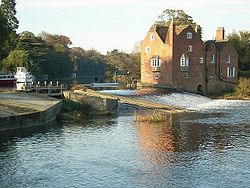Fladbury
This article needs additional citations for verification. (June 2009) |
| Fladbury | |
|---|---|
 River Avon - Cropthorne Mill | |
Location within Worcestershire | |
| Population | 750 |
| District | |
| Shire county | |
| Region | |
| Country | England |
| Sovereign state | United Kingdom |
| Post town | Pershore |
| Postcode district | WR10 |
| Dialling code | 01386 |
| UK Parliament | |
Fladbury is a traditional English village located in rural Worcestershire, England. The village was mentioned in the Domesday Book of 1086, almost 1,000 years ago. It is sited on the banks of the River Avon, with many interesting and original buildings and features. Cropthorne village is on the opposite bank of the Avon. The two ancient communities are linked by the Jubilee Bridge.
History[edit]
Fladbury was a settlement mentioned in Domesday Book, in the hundred of Oswaldslow and the county of Worcestershire. It had a recorded population around 250 people in 60 households in 1086, putting it in the largest 20% of settlements recorded in Domesday.
A Beaker settlement was discovered in the centre of Fladbury during excavations into Saxon occupation.[1] Excavations of the Beaker site took place from 1932 to 1941.[2]
Landmarks[edit]
The church of St John the Baptist in Fladbury is located in the village centre. It has been a site of Christian worship since monks settled here in 691AD when Ethelred, King of Mercia, made a grant of land to Oftfor the then Bishop of Worcester. The monks later moved on to found the monastery that became Evesham Abbey.
No trace of the early Saxon building remains, and the present building dates from the 12th century, with only the base of the tower dating back to Norman times. The church was rebuilt in 1340 with significant restorations taking place during Victorian times. The tower has a ring of eight bells which were rehung on a new frame in 1991.[3] The famous statesman, Sir John Throckmorton of Throckmorton Manor, Knt., (d. 12 April 1445) was interred in a large altar tomb in Fladbury Church.[4]
Fladbury Mill is a grade II listed building, listed in February 1965. It dates mainly from the 18th century, and is constructed of brick to an irregular plan. It has gabled wings; one gabled bay is of earlier timber framing.[5] The oldest part of the current Grade II listed building at Fladbury Mill dates from c 1650, when Fladbury Lock was built and the weir levels were raised.
Fladbury Mill has great local importance and of national significance. In 1888 electricity from the mill was used to power a few houses in the village. By 1900, two turbines were installed and the mill powered the village’s street lighting and houses at “a penny per light per night”. In the late 1970s a new turbine was installed which now provides electricity for all purposes at the mill, generating more than can currently be used.
Cropthorne Mill is sited on the far side of the river from Fladbury village, on the other side of the weir to Fladbury Village. It is a listed building built in two parts. More recent living accommodation was built probably in the 18th century was added to the much older working original Mill.
Further detailed information is in a book written by a former owner and can be viewed on the external links on this page.
Education[edit]
A voluntary-aided Church of England First School provides education to around 85 children aged 4 to 10. A September 2007 Ofsted inspection accorded the school a Grade 2 (good).[6]
Fladbury Walkabout[edit]
Fladbury Walkabout is an Open Gardens and Flower Festival, which runs on the first weekend of July each year (6 and 7 July in 2024). The event normally includes market stalls, live music, classic cars, children's activities, boat trips and refreshments, together with a Fun Run on the Sunday.[7]
Sporting Clubs[edit]
Fladbury has a number of sporting clubs, including a cricket club, football club, paddle club and tennis club all based on the recreation ground. The existing playing field (4.628 acres) was purchased by Fladbury Parish Council for £600 in November 1951.
Fladbury Cricket Club[8] was established in 1876. Its first match was against Toddington, Gloucestershire. The first formal fixture played on the current ground was on 6 June 1954 against Comberton. The changing room was in a nearby public house and teas cost 1s 9d. In 1985, Fladbury Cricket Club joined a league for the first time. This league was merged with others to create the Worcestershire County League in 1999.
Fladbury Football Club plays in the Evesham & District Sunday Football League.
Fladbury Paddle Club[9] uses the River Avon. It runs annual regattas.
John Singer Sargent[edit]
The American artist John Singer Sargent visited Fladbury in 1889. His painting, 'Two Girls with Parasols at Fladbury',[10] is in the Metropolitan Museum of Art in New York.
FladFest[edit]
Fladbury held its first annual music festival to celebrate local bands on 26 April 2024. This was held in the Village Hall. The next FladFest is planned for 26 April 2025.[11]
References[edit]
- ^ Taylor, Christopher "Village and Farmstead" p43
- ^ The Institute of Archaeology & Antiquity, University of Birmingham Retrieved 27 May 2016
- ^ "Church".
- ^ "THROCKMORTON, John (d.1445), of Throckmorton in Fladbury, Worcs. and Coughton, Warws. | History of Parliament Online". www.historyofparliamentonline.org.
- ^ Fladbury Mill at Heritage Gateway Retrieved 27 May 2016
- ^ Ofsted report September 2007[permanent dead link] Retrieved 30 July 2009
- ^ "- Walkabout". www.fladburyvillage.co.uk.
- ^ https://www.fladburycc.co.uk/history-brief.php
- ^ https://fladburypaddleclub.org
- ^ Natasha. "John Singer Sargent's Two Girls with Parasols at Fladbury". jssgallery.org.
- ^ https://www.fladfest.uk/

